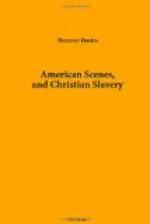I found on board a Baptist minister from the State of Maine, in New England, a thorough anti-slavery man. His testimony against the South on this subject was strong. He had lately been on a visit to a brother minister of his own denomination in North Carolina. At first, whenever the New Englander desired to go into the yard, it was necessary for his reverend brother to accompany him, and introduce him to a number of large dogs; otherwise they would have worried him.
These animals were kept to prevent his reverence’s slaves from running away, and to hunt them if they did. And yet, as my travelling companion assured me, this reverend slave-holder gravely and pathetically complained of the reluctance of the slaves to attend family worship!
LETTER XII.
Voyage up the Mississippi (continued)—“Patriarchal” Establishments—The Red River—Elder Wright—Lynch-Law administered by a Preacher—Natchez —Story of Mary Brown—The Flat Boats of the Mississippi.
On the 10th of February we passed a great many sugar estates on both sides of the river, which would be agreeable objects but for the curse of slavery. For who can look with pleasure upon the foul abodes of lust, oppression, and cruelty? At the outer gate, in front of one of these “patriarchal” establishments, was a small octagonal building about 6 or 8 feet in mean diameter. The basement was of brick, pierced by small air holes, barred with iron, at the height of about 8 feet from the ground; and the upper part was of wood, terminating in a pigeon-house. Making a short stay there to take in fire-wood, we inquired into the use of the building; but all the answer we could get was, that it was a “pigeon-house.” The Baptist minister from Maine asked a negro, who was helping to bring wood on board; and from him he learned the real truth,—that it was a place of punishment and torture for the oppressed slave. We have since ascertained that such buildings are very common, and generally pass under the euphemistic name of “pigeon-houses.”
On the 11th of February—a fine frosty day—we came to Red River, branching on our left in the direction of Texas, with which country it forms an important means of communication. This river, even where it pours its waters into the Mississippi, is not more than from 300 to 500 feet wide, and yet is navigable by steamers for about 1,200 miles. My Baptist friend had recently been on a visit to Elder Wright, a planter and a slave-holder on that river. This Wright was a New-England man, had graduated at Yale College, and boasted that he was “a Northern man with Southern feelings.” He was called Elder Wright because he was a preacher,—the Baptists here calling all preachers “elders.” Now, this Elder Wright told my friend that a few years ago there was great fear in his district of the slaves rising up against their masters. To this they were supposed to be instigated by the presence and




